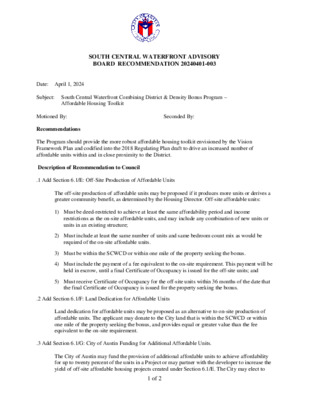Item 3 Draft Recommendation for Affordable Housing Tool Kit — original pdf
Backup

SOUTH CENTRAL WATERFRONT ADVISORY BOARD RECOMMENDATION 20240401-003 Subject: South Central Waterfront Combining District & Density Bonus Program – Affordable Housing Toolkit Seconded By: Date: April 1, 2024 Motioned By: Recommendations The Program should provide the more robust affordable housing toolkit envisioned by the Vision Framework Plan and codified into the 2018 Regulating Plan draft to drive an increased number of affordable units within and in close proximity to the District. Description of Recommendation to Council .1 Add Section 6.1/E: Off-Site Production of Affordable Units The off-site production of affordable units may be proposed if it produces more units or derives a greater community benefit, as determined by the Housing Director. Off-site affordable units: 1) Must be deed-restricted to achieve at least the same affordability period and income restrictions as the on-site affordable units, and may include any combination of new units or units in an existing structure; 2) Must include at least the same number of units and same bedroom count mix as would be required of the on-site affordable units. 3) Must be within the SCWCD or within one mile of the property seeking the bonus. 4) Must include the payment of a fee equivalent to the on-site requirement. This payment will be held in escrow, until a final Certificate of Occupancy is issued for the off-site units; and 5) Must receive Certificate of Occupancy for the off-site units within 36 months of the date that the final Certificate of Occupancy is issued for the property seeking the bonus. .2 Add Section 6.1/F: Land Dedication for Affordable Units Land dedication for affordable units may be proposed as an alternative to on-site production of affordable units. The applicant may donate to the City land that is within the SCWCD or within one mile of the property seeking the bonus, and provides equal or greater value than the fee equivalent to the on-site requirement. .3 Add Section 6.1/G: City of Austin Funding for Additional Affordable Units. The City of Austin may fund the provision of additional affordable units to achieve affordability for up to twenty percent of the units in a Project or may partner with the developer to increase the yield of off-site affordable housing projects created under Section 6.1/E. The City may elect to 1 of 2 subsidize residential units in these developments for rental or ownership purposes in any amount and at any level of affordability pursuant to criteria and procedures established by the Housing Director. Rationale: The Vision Framework Plan required 20% on-site affordable production for both rental and ownership units. In doing so it stated that achieving this would require partnerships between the City and the private property owners, participation by various affordable housing providers and a strong portfolio of affordable housing tools. The current Combining District program, however, has a much smaller on-site requirement (somewhere between 2-4% depending on max FAR), allows a fee-in-lieu exception for all ownership units, and provides no other alternative tools where developers could use those same dollars in more creative ways or allow the COA to step in with additional funding. The SCWAB understands that rising land values, stubbornly high construction costs and a difficult lending environment have made it increasingly challenging for developers to deliver on-site affordable housing in dense high-rise projects, especially for ownership units with the added burden of HOA costs. We also understand that reducing the on-site requirement is part of a necessary policy shift to increase Fee-in-Lieu returns so that those dollars can make up for a shortfall in funding for infrastructure and parkland improvements in the District. However, one has to question the end result of simultaneously reducing the on-site requirement and removing all the alternative tools that could actually increase unit count. While the Planning Department argues that there will be a similar number of affordable units in aggregate spread throughout the District (481 projected in the SCWD compared to 527 projected in the VFW), this is a very misleading argument because it ignores the 5-10 times greater yield anticipated in upcoming projects. If the Vision Framework target were still in place, that number could be well above 3,000 units. As it stands now, the few units created by the SCWD are going to be so infrequent and isolated that their value in crafting an equitable and inclusive community should be questioned. For example, under the Vision Framework Plan, a project like 500 South Congress with 800 residential units would have 640 market-rate units and 160 affordable units. Under the CD Program, that has shifted to 779 market-rate units and only 21 affordable units. Given the above, we would strongly encourage the Planning Department to reintroduce the more robust toolkit recommended by both the Vision Framework Plan and 2018 Regulating Plan draft allowing for off-site production of affordable units, land dedication for affordable housing, and COA funding for additional units should these prove to increase the number of affordable units in close proximity to the District or derive a greater community benefit. Vote For: Against: Abstain: Absent: Attest: [Staff or board member can sign] 2 of 2